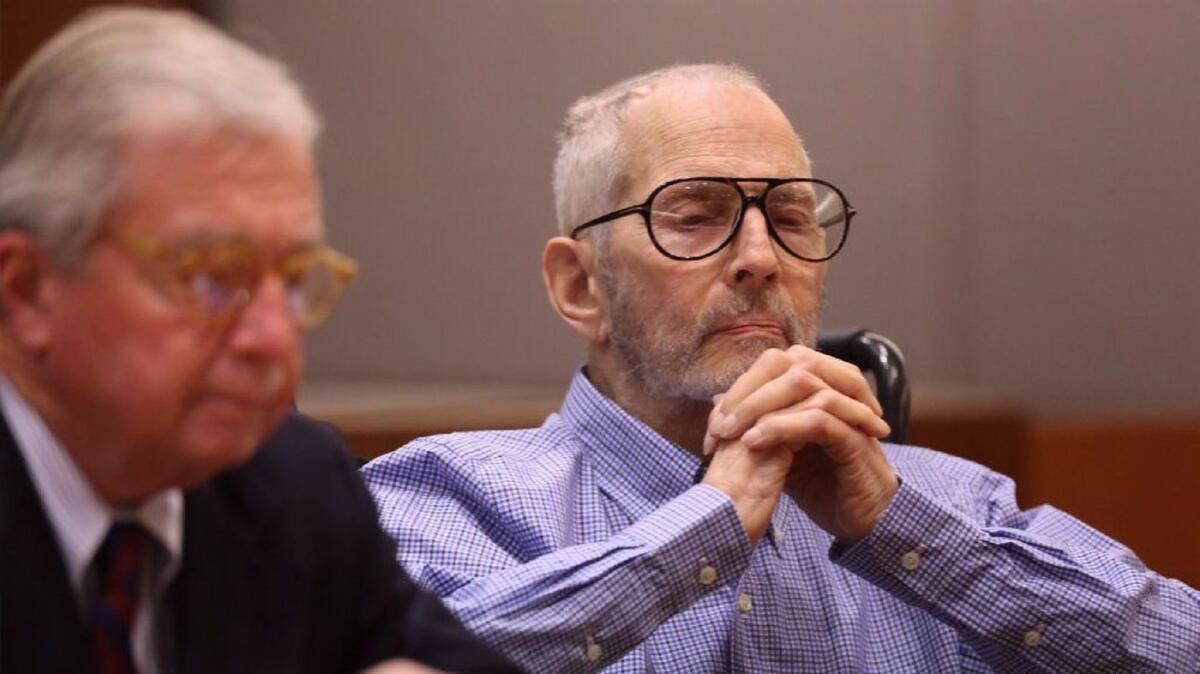Prosecutors lay out their case against Robert Durst, arguing he should stand trial for murder

- Share via
Grisly autopsy photos flashed on the screen in the Los Angeles courtroom. One focused on the spot where a bullet tore through the back of Susan Berman’s scalp, another showed red splotches on her backside — places where blood settled after she was shot inside her Benedict Canyon home in 2000.
At the defense table, Robert Durst, who is accused of killing his close friend, stared at the photographs without expression.
The New York real estate tycoon appeared in court Monday for a preliminary hearing — a crucial step in the murder case prosecutors have built against him. At the end of the hearing, a judge will decide if there’s enough evidence for the eccentric multimillionaire to stand trial in the slaying of Berman, a crime writer and the daughter of a Las Vegas mobster.
Prosecutors argue that Durst, who has pleaded not guilty, killed to cover his tracks — he was afraid Berman would tell investigators what she knew about the 1982 disappearance of Durst’s wife, Kathleen, whose body has never been found.
Los Angeles prosecutors and Kathleen’s family believe Durst killed his wife but managed to evade justice. Durst’s defense team says New York police conducted a thorough missing person investigation years ago and argue their client wasn’t charged because he’s innocent.
In court Monday, former L.A. County Medical Examiner-Coroner Mark Fajardo testified that although he didn’t conduct Berman’s autopsy, he’d reviewed the coroner’s case file, including photographs of her remains. The star-shaped entrance wound on the back of her head, Fajardo said, was a telltale sign that she was shot at very close range.
The muzzle, Fajardo said, “was either directly on the skin or probably within an inch.”
Under cross-examination, he acknowledged the autopsy found the range of fire to be “indeterminate” but said he disagreed with that conclusion.
At times during Fajardo’s testimony, Durst, 75, closed his eyes and appeared to nod off.
Another witness, Karen Minutello, testified that in 1982 she managed the New York complex where Robert and Kathleen Durst lived in a 15th-floor apartment. She occasionally saw the couple in the hallway and sometimes made small talk with Kathleen, Minutello said, adding that one specific conversation — a phone call from Kathleen not long before she disappeared — has stayed with her through the years. Kathleen called to ask if there were any vacant apartments in the building, the witness said, adding that despite an initial hesitance to open up, Kathleen told her that she no longer wanted to live with her husband.
A prosecutor asked Minutello if Kathleen told her why she needed to get away from her husband.
“She was afraid of him,” the witness responded.
Minutello also testified that in 1982 she went to the building’s basement and found a porter pulling clothing, books, makeup and other personal items from a clogged trash compactor. One of the books, the witness said, had Kathleen Durst’s name on it. The incident struck her as significant, she said, because it came “days after” Kathleen went missing.
“Who does that?” Minutello said. “Whose loved one is missing and you throw out their stuff?”
The witness testified that she recalled getting a letter from Durst on Feb. 4, 1982 — the day before he reported Kathleen missing to police — asking if he could sublease the apartment.
Minutello also told the court that she didn’t notify police at the time because the man she would eventually marry — a former NYPD officer — told her the cops would come to her if they needed her.
Key elements of the prosecution’s case had already emerged during pretrial hearings. A bombshell came last year when Durst’s longtime friend Nick Chavin testified that Durst had once confessed to killing Berman, their mutual friend.
“I had to. It was her or me,” Durst said, according to Chavin’s testimony. “I had no choice.”
The multimillionaire was arrested at a New Orleans hotel in connection with Berman’s slaying on March 14, 2015 — a day before the finale of “The Jinx,” a six-part HBO documentary about Durst.
In the final episode, Durst is captured on a hot microphone muttering, “What the hell did I do? Killed them all, of course.” Some have interpreted the mumbled comment to be a confession to three killings — those of Berman and his wife, as well as the fatal shooting of Morris Black, a neighbor in Texas.
Durst was charged in the Texas case, but was acquitted in 2003 after arguing that the gun fired while he was defending himself during a struggle. He also admitted to dismembering the body and dumping the parts in Galveston Bay.
Durst’s defense team contend there is no evidence that Kathleen Durst was murdered.
“Any suggestion to the contrary by the people,” the lawyers argued in a court filing, “is simply not supported by the record or evidence.”
His attorneys also argue that the sensation surrounding the HBO documentary rather than facts led to his arrest.
Durst’s preliminary hearing will resume Tuesday.
For more news from the Los Angeles County courts, follow me on Twitter: @marisagerber
More to Read
Sign up for Essential California
The most important California stories and recommendations in your inbox every morning.
You may occasionally receive promotional content from the Los Angeles Times.











